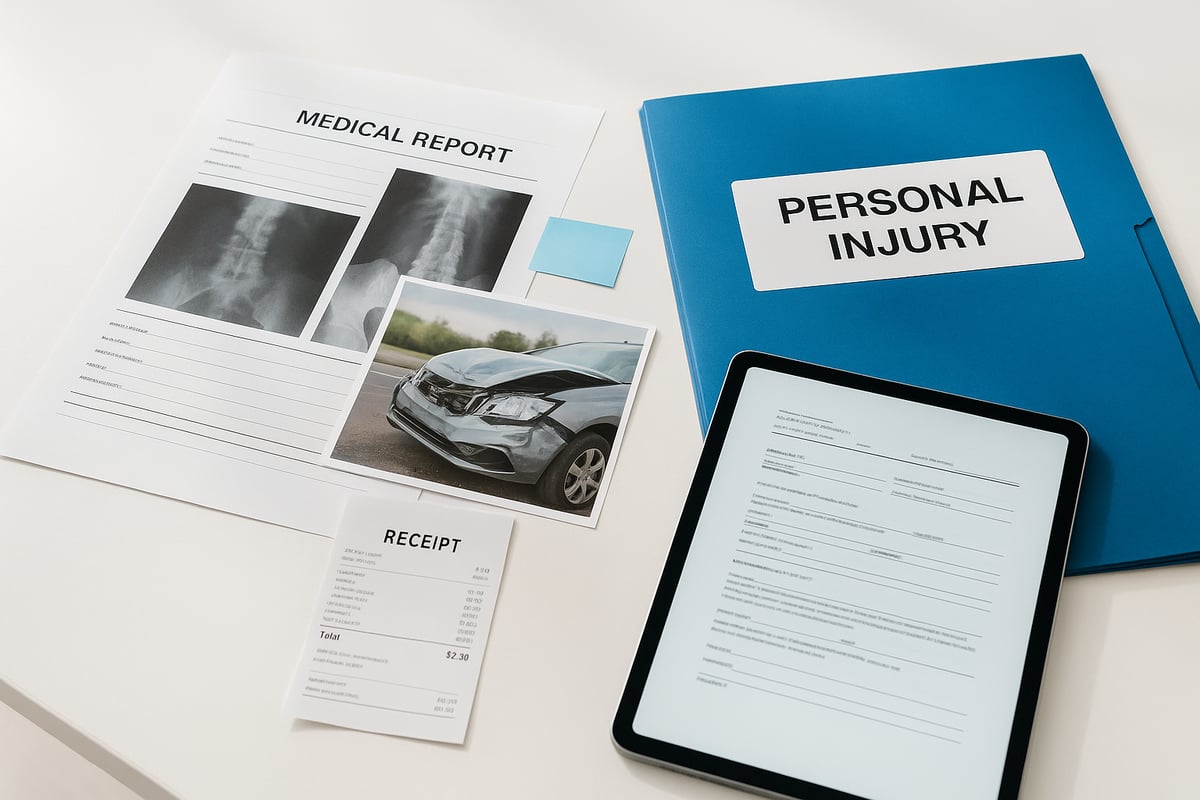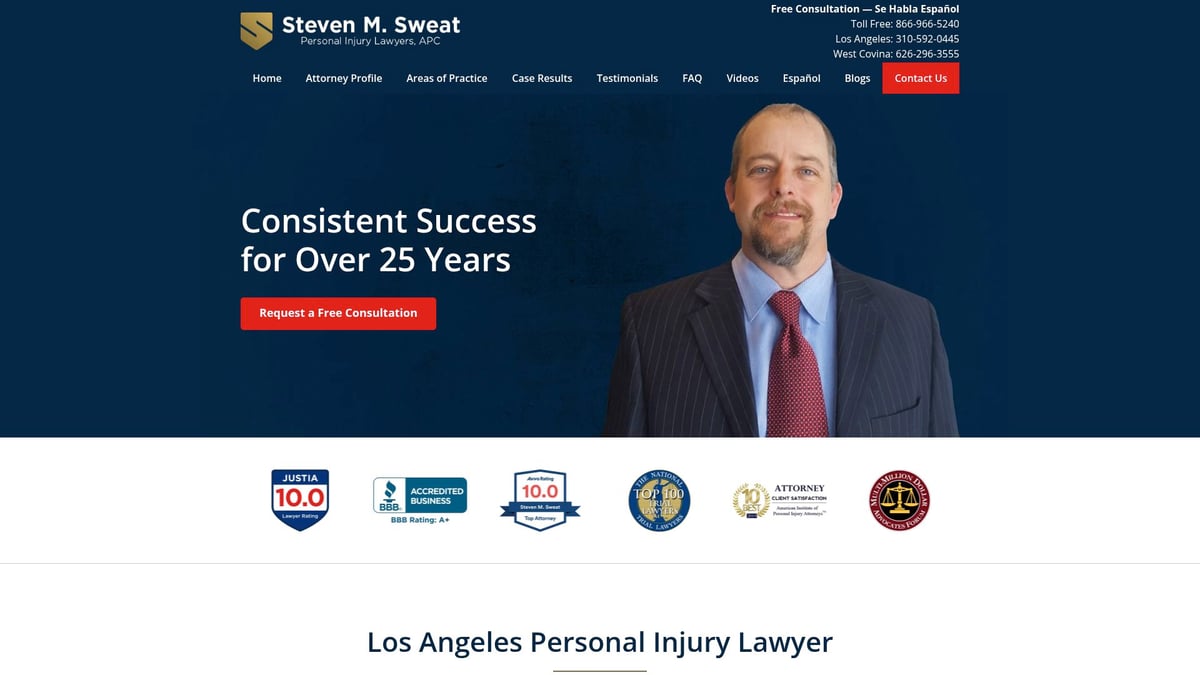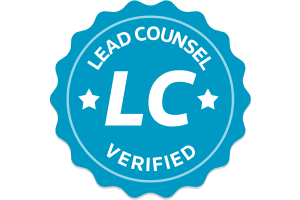- Free Consultation: 866-966-5240 Tap Here To Call Us
Lawyer for Injury Guide: Essential Steps for 2025
Every year, thousands of people experience life-changing injuries, leaving many unsure where to turn next. The decisions you make in the first hours and days can shape your future. That is why having the right lawyer for injury cases is more important than ever in 2025.
This guide breaks down the essential steps you need to take after an injury. Our goal is to empower you with clear, up-to-date advice for navigating the legal process, protecting your rights, and maximizing your claim.
You will learn what to do immediately after an accident, how to gather evidence, find the right attorney, handle negotiations, and prepare for potential changes in the law. Read on for expert guidance and peace of mind.
Step 1: Immediate Actions After an Injury
When an injury happens, your first steps can shape the entire outcome of your recovery and claim. Acting quickly and thoughtfully not only protects your well-being but also strengthens your legal standing. Here is what you need to do immediately after any accident or injury.
Assessing and Ensuring Safety
Your safety and the well-being of others always come first. Immediately check for injuries to yourself and anyone else involved. If someone needs urgent help, call emergency services without delay.
Before moving vehicles or objects, document the scene if it is safe. Take quick photos or videos from several angles. This step can be crucial for your future case with a lawyer for injury.
In many states, you have a legal duty to assist others after an accident. For example, a quick emergency call and basic first aid often reduce long-term complications for everyone.
Remember, ensuring safety is not only about health. It is also about fulfilling your legal obligations and setting the right foundation for your claim.
Reporting the Incident
Next, report the incident to the appropriate authorities. For car accidents, contact local law enforcement. In workplace or property incidents, notify management or security right away.
Always file an official accident report. Include details like the time, location, parties involved, and a summary of what happened. These reports are critical evidence for any lawyer for injury working on your behalf.
Police reports, for instance, often become the backbone of car accident claims. In fact, 85 percent of successful claims include a properly filed incident report. For more on your legal rights at this stage, review Understanding your personal injury rights.
Accurate reporting can make the difference between a smooth claim and a prolonged dispute.
Preserving Evidence
Strong evidence is your best ally. Use your phone to photograph injuries, vehicle damage, and the full scene from multiple perspectives.
Collect names and contact details of witnesses while memories are fresh. If possible, record short witness statements onsite. Keep any physical evidence, such as damaged clothing or personal items, safe for your lawyer for injury to review.
Note the weather, lighting, and surrounding conditions. Even small details can become crucial later. In many cases, clear photos have led to higher settlement offers and faster resolutions.
Being thorough now saves time and stress later in the process.
Seeking Medical Attention
Even if you feel fine, seek a prompt and thorough medical evaluation. Some injuries, like whiplash, may not show symptoms right away but can worsen over time.
Make sure your doctor documents every symptom and injury. These medical records are essential for your lawyer for injury to build a strong case. Follow up on all recommendations, including referrals to specialists if needed.
Remember, delayed treatment can reduce your claim’s value by up to 30 percent. Many clients have discovered hidden injuries days later, so never skip this step.
Early, detailed medical care supports both your health and your legal claim.
Avoiding Common Mistakes
After an accident, avoid discussing fault or apologizing at the scene. Do not share details about the incident on social media, as insurers and defense lawyers monitor posts for evidence.
Never accept an early settlement offer from an insurer without consulting a lawyer for injury. Social media posts have been used against claimants, costing them fair compensation.
A simple mistake—like admitting fault or missing documentation—can jeopardize your case. Stay cautious and consult legal counsel before making any statements.
Protecting your rights from the start is the best way to maximize your recovery.
Step 2: Gathering Documentation and Evidence
After an accident, the quality and organization of your evidence can make a significant difference in the outcome of your case. A skilled lawyer for injury will always emphasize the importance of thorough documentation. By following these steps, you put yourself in the best possible position for a successful claim.
Types of Evidence Needed
To build a strong case, collect all relevant evidence as soon as possible. A lawyer for injury will recommend gathering:
- Medical records and bills documenting every treatment
- Official accident or incident reports
- Photos and videos of the scene, damages, and injuries
- Witness statements with contact details
- Employment and wage records for lost income claims
For example, medical bills not only prove your expenses but also support claims for pain and suffering. The more comprehensive your evidence, the easier it is for your lawyer for injury to demonstrate liability and damages in your case.
Organizing Your Documentation
Proper organization ensures that key documents are easy to access and present during negotiations or court proceedings. Your lawyer for injury will advise you to keep a chronological file, starting from the day of the incident. Use both digital and physical storage, backing up photos and scans in secure cloud services.
Consider labeling folders by category, such as “Medical,” “Police Reports,” or “Correspondence.” This organization streamlines communication with your lawyer for injury and supports efficient case management. For instance, having all your photos in a cloud folder allows quick sharing and review.
Tracking Expenses and Losses
Thorough documentation of financial losses is essential. Keep every receipt for out-of-pocket costs, including medication, travel to appointments, and medical devices. Your lawyer for injury will also need detailed records of missed work and statements from your employer to calculate lost wages and future earning capacity.
Tracking non-economic damages, like pain and emotional distress, strengthens your claim. According to Personal Injury Statistics in 2025: A Comprehensive Overview, claimants who meticulously track their expenses achieve settlements up to 20 percent higher than average. Accurate records give your lawyer for injury the tools to maximize your recovery.
Communicating with Insurance Companies
When dealing with insurers, clarity and caution are vital. Your lawyer for injury will tell you to provide only necessary information and avoid giving recorded statements without legal advice. Keep a log of every call, email, or letter, noting dates and the names of adjusters.
Do not speculate or admit fault. Instead, refer adjusters to your lawyer for injury when questions go beyond basic facts. For example, if an insurer asks for a recorded statement, politely decline until you have consulted your legal representative.
When to Seek Legal Help for Evidence
Certain situations require immediate assistance from a lawyer for injury. If your case involves multiple parties, catastrophic injuries, or disputed liability, legal intervention is crucial. An experienced attorney can obtain surveillance footage, hire expert witnesses, and navigate statute of limitations issues.
For example, your lawyer for injury may secure expert reports or reconstruct the accident scene to clarify fault. When evidence is complex or at risk of being lost, prompt legal action ensures your rights are preserved and your case is as strong as possible.
Step 3: Choosing the Right Lawyer for Injury Cases
Selecting the right lawyer for injury can make the difference between a fair settlement and a lost opportunity. In 2025, the legal landscape is more competitive than ever, so knowing how to evaluate and choose your advocate is essential. This section breaks down the most important factors to consider, ensuring you find a lawyer for injury who will fight for your best interests.
Qualities to Look for in a Personal Injury Lawyer
When searching for a lawyer for injury, prioritize experience with cases like yours, proven results, and a strong reputation. Look for:
- Years of practice in personal injury law
- Successful settlements and trial verdicts
- Clear, responsive communication
- Positive client testimonials and reviews
- Membership in respected legal organizations
A lawyer for injury should demonstrate deep knowledge of statutes and recent case law. For a detailed breakdown of vital attorney attributes, see Essential injury attorney qualities. Choosing a lawyer with these qualities can significantly impact your case outcome.
Questions to Ask During Consultations
During your initial meetings, ask direct questions to assess whether the lawyer for injury is the right fit:
- Who will manage my case day to day?
- What is your fee structure, and are there any upfront costs?
- How frequently will you update me on my case’s progress?
- Do you prefer to settle, or are you prepared to go to trial?
- Can you provide examples of similar cases you have handled?
The answers help you understand the lawyer for injury’s approach and whether their style aligns with your needs. A transparent consultation sets clear expectations and builds trust from the start.
Understanding Contingency Fees and Costs
Most lawyer for injury arrangements are based on contingency fees, typically ranging from 33% to 40% of your recovery. This means you owe nothing unless you win. Be sure to clarify:
- What percentage will be taken as a fee
- Which expenses are covered by the lawyer, and which you might be responsible for
- The process for reimbursing costs if your case is unsuccessful
A reputable lawyer for injury will explain all terms in writing, so you know exactly what to expect financially. This transparency protects you from surprises down the road.
Evaluating Local vs. National Firms
Deciding between a local or national lawyer for injury? Each has distinct advantages. Consider the following table for a quick comparison:
| Aspect | Local Firms | National Firms |
|---|---|---|
| Courtroom Experience | Deep local knowledge | Broader but less local focus |
| Personalized Service | More individualized | Often more standardized |
| Resources | May be more limited | Access to larger support teams |
| Familiarity w/ Laws | Up-to-date on state-specific changes | General knowledge across jurisdictions |
A local lawyer for injury often brings valuable insight into regional procedures and relationships, which can be decisive in your case.
Steven M. Sweat, Personal Injury Lawyers, APC: Los Angeles Experts
If you need a lawyer for injury in California, Steven M. Sweat, Personal Injury Lawyers, APC, stands out with over 25 years of experience. They offer free consultations, no fees unless you win, and support in multiple languages. Their team is recognized by Super Lawyers, Avvo, and Top 100 Trial Lawyers.
The firm’s lawyer for injury services are available 24/7, with home and hospital visits for those unable to travel. Their personalized approach ensures every client receives comprehensive support, from evidence gathering to final settlement.
Step 4: Navigating the Injury Claims Process in 2025
The injury claims process in 2025 is more complex and time-sensitive than ever. Knowing how to navigate each stage is vital to protect your rights and maximize your outcome. A skilled lawyer for injury cases can help you avoid pitfalls and ensure that every deadline is met.
Filing a Claim: Timelines and Deadlines
The first step in any injury case is filing your claim within the required timelines. Each state sets a statute of limitations for personal injury lawsuits. For example, in California, you generally have two years from the date of injury to file a lawsuit. Some claims, such as those against government entities, may have even shorter deadlines. Your lawyer for injury will ensure all necessary paperwork is submitted on time, including incident reports and insurance notifications. Missing a deadline can result in losing your right to recover compensation. Early legal guidance is crucial to avoid costly mistakes and preserve your claim.
Investigation and Liability Determination
Once your claim is filed, the investigation phase begins. Insurance companies and lawyers for injury victims work to gather evidence, review police reports, and consult expert witnesses. Accident reconstruction may be necessary in complex cases. Determining liability is key, especially when multiple parties are involved. Comparative fault rules can affect your compensation if you are found partially at fault. According to Personal Injury Law Statistics: Insights and Trends for 2025, about 40 percent of claims involve disputed liability. A knowledgeable lawyer for injury will navigate these complexities and advocate for your interests.
Medical Treatment and Maximum Medical Improvement (MMI)
After an injury, it is essential to follow your doctor’s advice and continue all recommended treatments. Your lawyer for injury will stress the importance of reaching maximum medical improvement (MMI) before settling your case. MMI is the point where your condition has stabilized and future medical needs are clear. Settling before reaching MMI can leave you without compensation for ongoing care. Detailed medical records showing your progress and prognosis are critical evidence. Your lawyer for injury will coordinate with medical professionals and ensure your recovery is fully documented.
Calculating Damages: Economic and Non-Economic
A lawyer for injury claims will help you calculate both economic and non-economic damages. Economic damages include medical bills, lost wages, and property loss. Non-economic damages cover pain and suffering, emotional distress, and loss of enjoyment of life. Future costs, such as rehabilitation or long-term care, must also be considered. Life care plans and expert testimony can support higher settlement amounts. Your lawyer for injury will use detailed records and expert analysis to present a comprehensive picture of your losses, ensuring nothing is overlooked.
Dealing with Insurance Adjusters and Defense Tactics
Insurance adjusters are trained to minimize payouts. They may use tactics such as requesting recorded statements, offering quick settlements, or disputing the extent of your injuries. Your lawyer for injury will handle all communications with insurers and protect you from common pitfalls. It is important not to provide more information than necessary or accept an initial offer without legal advice. If adjusters challenge your claim, your lawyer for injury can escalate the matter to litigation or seek independent expert evaluations to strengthen your case.
Settlement Negotiations and Mediation
Most injury claims settle before reaching trial. Your lawyer for injury will draft a demand letter and negotiate with the insurer for a fair settlement. Mediation may be used to resolve disputes without a trial, resulting in faster and less stressful outcomes. Over 90 percent of personal injury cases are resolved through negotiation or mediation. With a lawyer for injury by your side, you gain leverage in discussions and can avoid common traps that lead to undervalued settlements. Preparation and skilled advocacy are your best tools for a successful resolution.
Step 5: Preparing for Litigation and Trial (If Necessary)
Facing a lawsuit can feel daunting, but understanding what lies ahead can help you approach the process with confidence. Whether you are considering filing or have already started, knowing how a lawyer for injury navigates litigation is crucial.
When to Consider Filing a Lawsuit
You may need to file a lawsuit if negotiations stall or the insurer outright denies your claim. A lawyer for injury often recommends litigation when liability is contested or injuries are severe. Watch out for the statute of limitations—missing it means losing your right to recover.
Common triggers for lawsuits include:
- Unreasonable settlement offers
- Complex multi-party accidents
- Catastrophic injuries with high damages
For detailed guidance on deciding when to escalate your claim, review these Expert tips for injury lawyers. Remember, consulting a lawyer for injury early can prevent costly mistakes.
The Litigation Process: What to Expect
Once your lawyer for injury files a complaint, the legal process formally begins. The defendant is served, and both sides enter the discovery phase. During discovery, parties exchange documents, answer questions under oath, and may attend settlement conferences.
Key stages include:
- Filing and serving the complaint
- Discovery (depositions, interrogatories)
- Pre-trial motions and hearings
Litigation timelines vary, often stretching from 12 to 24 months. Throughout, your lawyer for injury will keep you informed and advise on each decision point.
Trial Preparation and Courtroom Procedures
As your case nears trial, meticulous preparation becomes vital. Your lawyer for injury will select a jury, craft opening statements, and prepare witnesses. Expert testimony is often arranged, especially for medical or technical details.
Typical steps in trial prep:
- Jury selection and voir dire
- Organizing exhibits and evidence
- Preparing direct and cross-examinations
In court, your lawyer for injury presents the facts clearly and persuasively. Compelling expert witnesses and well-documented evidence can be decisive for your outcome.
Possible Outcomes and Appeals
After trial, the jury or judge delivers a verdict. You may win, lose, or be found partially at fault. If the result is unfavorable, your lawyer for injury can advise on post-trial motions or appeal options.
Possible outcomes include:
- Full compensation awarded
- Partial fault reducing damages
- Denial of claim
Appeals are complex and can extend the process. Still, most cases settle before reaching trial, saving time and stress. Your lawyer for injury remains your advocate, helping you understand and pursue every available remedy.
Step 6: Trends and Key Changes in Personal Injury Law for 2025
Staying informed about current trends is vital for anyone seeking a lawyer for injury in 2025. The legal landscape is evolving rapidly, and understanding these changes can directly impact your legal strategy and outcome. Below, we break down the most significant shifts that injury claimants should know.
New Legislation and Regulatory Updates
Recent legislative changes are shaping how a lawyer for injury approaches new claims. California, for example, has updated its comparative fault rules, affecting how damages are calculated when multiple parties share responsibility. Nationally, several states have introduced stricter caps on non-economic damages, especially in catastrophic injury cases.
Key updates include:
- Adjusted statutes of limitations for certain injuries
- Enhanced disclosure requirements for insurance policies
- Streamlined procedures for government claims
For those working with a lawyer for injury, staying current on these rules helps avoid costly mistakes and supports a stronger case. Always verify your state’s most recent regulations before proceeding.
Technology’s Role in Injury Cases
Technology is transforming how a lawyer for injury gathers and presents evidence. Dashcams, wearable health trackers, and even building surveillance footage are increasingly used to establish timelines and prove injuries. In 2025, digital health records and AI-driven claims analysis are making case preparation more efficient and accurate.
Common tech tools include:
- Dashcams and vehicle telematics
- Wearable devices tracking physical activity and health metrics
- Secure cloud storage for evidence
According to Injury-Impact-2025, the use of digital evidence and analytics is helping both lawyers and insurers assess claims faster and more reliably. For anyone seeking a lawyer for injury, leveraging technology can be the difference between a denied claim and a favorable settlement.
Evolving Insurance Practices
Insurance companies are adopting advanced digital tools to manage injury claims. For a lawyer for injury, this means navigating automated claims systems, AI-driven fraud detection, and virtual communications with adjusters. Insurers are also using predictive analytics to evaluate settlement offers and identify potential litigation risks.
Current trends include:
- Automated claim assessment tools
- Virtual negotiations and mediations
- Enhanced fraud detection algorithms
With over 70 percent of insurers implementing these technologies, a lawyer for injury must be proactive in responding to automated processes and ensuring that claimants’ rights are fully protected.
Societal and Economic Factors
Rising medical costs and growing public awareness of mental health are influencing the value of injury claims in 2025. Juries are more receptive to non-economic damages, and settlements are reflecting the true impact of injuries on daily life. For anyone hiring a lawyer for injury, understanding these broader trends is crucial.
Key factors shaping claims:
- Increased awards for pain, suffering, and emotional distress
- Escalating healthcare expenses affecting settlement amounts
- Greater emphasis on long-term care and rehabilitation
For a comprehensive overview of these trends, see A Deep Dive into Personal Injury Law Statistics for 2025. Staying updated helps both clients and their lawyer for injury maximize recovery and adapt to a shifting legal environment.
Step 7: Protecting Your Rights and Maximizing Recovery
Recovering from an injury is about more than just healing physically. Protecting your rights and maximizing your recovery ensures you do not leave money or opportunities on the table. Taking the right steps with a lawyer for injury can make all the difference in both the short and long term.
Avoiding Pitfalls and Common Mistakes
One of the most common reasons injury claims fail is simple error. Missing a deadline, submitting incomplete paperwork, or speaking directly to insurers without a lawyer for injury present can jeopardize your entire case. Statute of limitations lapses are particularly devastating, as they can permanently bar recovery.
- Missing critical deadlines
- Failing to collect or organize documentation
- Discussing your case on social media
- Accepting early settlement offers without legal review
For example, many claimants lose their right to compensation simply by waiting too long to act. Always keep track of important dates and consult with a legal professional as soon as possible.
Leveraging Expert Legal Representation
Having an experienced lawyer for injury on your side can significantly increase the value of your claim. Studies show that represented claimants receive three times higher settlements on average than those who go it alone. A specialist understands the nuances of your injury type and the tactics insurers use to minimize payouts.
When choosing a lawyer for injury, look for someone with a proven track record, clear communication, and a focus on client outcomes. Not sure where to start? You can review the Best injury lawyer picks in 2025 to find reputable options in your area.
A strong legal advocate will handle negotiations, gather evidence, and protect your rights at every stage.
Understanding Settlement Agreements
Before signing a settlement agreement, it is crucial to review every term carefully with your lawyer for injury. Settlement documents often contain waivers and conditions that could impact your future rights. Tax implications may also arise, especially with large lump-sum payments.
Consider whether a structured settlement is right for you. These arrangements can provide long-term financial security, especially for ongoing medical care. Your lawyer for injury will help you understand the pros and cons, ensuring you are not caught off guard by unexpected obligations.
Taking time to understand your agreement can prevent costly mistakes down the road.
Planning for the Future Post-Settlement
Once your case is resolved, planning for the future is key. Work with your lawyer for injury and financial advisors to manage settlement funds responsibly. Allocate resources for medical expenses, rehabilitation, and daily living needs.
- Set up a system for tracking ongoing costs
- Explore options for life care planning
- Seek out support networks and rehabilitation resources
Proper planning ensures your recovery is sustainable and that you have access to the care you need. Remember, the goal is not just compensation, but long-term well-being and peace of mind.
Navigating a personal injury can feel overwhelming, but taking the right steps from the very start makes all the difference in your recovery and your claim. As we’ve discussed, documenting everything, seeking timely medical care, and choosing the right legal help are crucial for protecting your rights in 2025. If you’re unsure about what to do next or just want to talk through your options, you don’t have to face it alone. Reach out for a Free Consultation No Fee Until We Win—it’s a simple way to get clarity and expert guidance at no risk to you.












